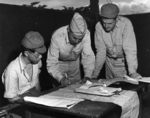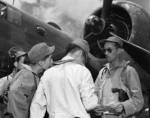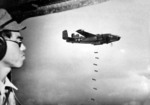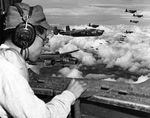Minoru Wada
| Surname | Wada |
| Given Name | Minoru |
| Country | Japan |
| Category | Military-Ground |
| Gender | Male |
Contributor: David Stubblebine
ww2dbaseVery little is known about the life and times of Minoru Wada except for a moment in time during August 1945; but what a remarkable moment that was.
ww2dbaseMinoru Wada was born in the United States and followed the Japanese-American Kibei custom of traveling to Japan for his education. He attended the University of Tokyo and then the Kyushu Military Academy. The Kibei practice was to return to America after their schooling but in Wada's case, the Pacific war broke out while he was in Japan and he was pressed into service in the Imperial Japanese Army. Wada became a junior officer in the Army's transportation section and by 1945 he was serving with the Japanese 100th Infantry Division on the southern Philippine island of Mindanao, General Jiro Harada commanding.
ww2dbaseAs the war progressed, Wada detested all the killing and he became very disillusioned with the nature of war. He never believed in the warring character exhibited by the "Old Guard" of the Japanese military. After seeing war up close, more than anything he wanted peace to return to the Japanese islands and to the Japanese people. As the Pacific war moved past the Philippines, past Iwo Jima, and was passing Okinawa, Wada's anti-war feelings began to fume as the fighting and dying on Mindanao seemed more and more pointless. Then, in the first week of August 1945, Wada was captured by American troops – defected, according to some sources – but in either case, he became a Prisoner of War.
ww2dbaseJapanese Prisoners of War were routinely interrogated by Intelligence personnel but the interviewers found an unusually sympathetic subject in Minoru Wada. He shared his disillusioned feelings about the war and described his strong wish for the war to end. He said he would do anything, even sacrifice his own life, to stop the war and bring ultimate peace to the Japanese people. The Army Intelligence officers offered him the chance to help the Americans end the war on Mindanao but he initially refused. Wada then reconsidered after going through a thought process that was eerily similar to what US President Harry Truman had just gone through days before and it led Wada to the same place: perhaps it was better for a smaller number of people to be killed now than for vastly larger numbers to be killed later. For Truman, this led to his decision to drop atomic bombs on Japan in the hopes of avoiding greater losses in an invasion; for Wada, this led to his decision to help US forces destroy General Harada’s well concealed headquarters complex in the hopes of avoiding greater losses from prolonged and pointless fighting.
ww2dbaseWada pointed out the headquarters location on maps but the rugged terrain and dense jungle of Mindanao's Kibawe-Talomo Trail region meant that the only sure way for the Americans to find the complex would be for Wada to take them there. Thus the stage was set for one of the most unusual raids of the war.
ww2dbaseOn August 9, 1945, the same day the second atomic bomb of the war was dropped on Nagasaki, Marine Bombing Squadron VMB-611 flying PBJ-1D Mitchell bombers and Marine Fighting Squadron VMF-115 "Joe's Jokers" flying F4U Corsair fighters prepared for take-off from Moret Field in Zamboanga, Mindanao bound for General Harada's headquarters. Wada helped brief the pilots and then the pilot of the lead plane had to add the names of three unusual passengers to his flight manifest: Army Ground Liaison Officer and Strike Coordinator Major Mortimer Jordan, interpreter Sergeant Charles Imai, and Imperial Japanese Army Second Lieutenant Minoru Wada. Still dressed in his Japanese Army uniform, Wada sat in the radio-gunner's position and looked for familiar landmarks. Speaking through Sergeant Imai, he was able to direct the bombers right to his own headquarters complex. The strike group then dropped 22,000 pounds of bombs on the area plus a healthy dose of 5-inch rockets.
ww2dbaseThe attack was extremely successful and the headquarters was thoroughly demolished. Major Jordan later told debriefing officers, "The Japanese officer put us zero on the target and we did the rest – maybe overdid it." The loss of the 100th Division's command and control establishment virtually ended the fighting on Mindanao overnight.
ww2dbaseMinoru Wada was very mindful about what he had helped bring about but he never regretted his decision to help the Americans. He was convinced that fewer lives were lost overall because of his assistance in this attack.
ww2dbaseThe war ended less than a week after the strike against the 100th Division headquarters. Minoru Wada was given a new identity and was never heard of again. It is not known where he went after the war or what became of him. Many aspects of this mission remained classified for decades and the event has still only been partially declassified.
ww2dbaseNote: Official United States Marine Corps photo captions as well as several internet sources say this air attack occurred August 10, 1945 but this is incorrect. The After Action Reports from both participating Marine Squadrons (VMB-611 & VMF-115) as well as their official War Diaries date the event as August 9, 1945.
ww2dbaseSources:
US Marine Corps; Photographic Section
US Marine Bombing Squadron 611 Action Report #158, Aug 7, 1945
US Marine Bombing Squadron 611 Action Report #159, Aug 9, 1945
US Marine Bombing Squadron 611 War Diary, Aug 1945
US Marine Fighting Squadron 115 Action Report #2, Aug 9, 1945
US Marine Fighting Squadron 115 War Diary, Aug 1945
John M. Curatola, LtCol USMC (ret); Flying Leatherneck Aviation Museum & Historical Foundation
Ray Mirriam; Mirriam Press
Titusville Herald, Titusville Pennsylvania, Aug 22, 1945
Fold3.com
Wikipedia
Last Major Revision: Feb 2015
Minoru Wada Mapa Interativo
Photographs
 |  |  |  |
Minoru Wada Timeline
| 9 ago 1945 | On Mindanao in the Philippines, captured Japanese Army officer Minoru Wada flew with US Marine Mitchell bombers to guide them to the Japanese Army 100th Infantry Division headquarters. The complex was destroyed and the fighting on Mindanao ended. |
Você gostou deste artigo ou achou este artigo útil? Se sim, considere nos apoiar no Patreon. Qualquer valor já vai ajudar! Obrigado. Por favor, ajude-nos a divulgar o site: Fique atualizado com WW2DB: |

» Philippines Campaign, Phase 2
- » 1,180 biografias
- » 337 eventos
- » 45,098 entradas na linha do tempo
- » 1,246 navios
- » 350 modelos de aeronaves
- » 207 modelos de veículos
- » 376 modelos de armas
- » 123 documentos históricos
- » 261 instalações
- » 470 eventos
- » 28,467 fotos
- » 365 mapas
General Douglas MacArthur at Leyte, 17 Oct 1944
Por favor, considere nos apoiar no Patreon. Mesmo R$1 por mês já faz uma grande diferença. Obrigado!
Ou, por favor, nos apoie adquirindo alguns produtos do WW2DB na TeeSpring. Obrigado!